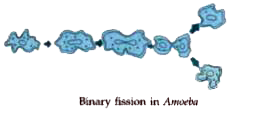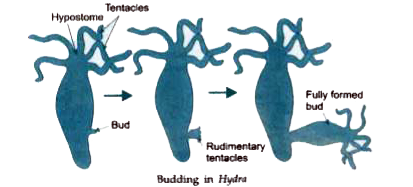Describe the process of fission, budding and spore formation in living organism.
Text Solution
Asexual reproduction occurs in following ways:
(i) Fission: It is the process of asexual reproduction in unicellular organisms, such as amoeba and paramecium. Fission is again of two types :
(a) Binary fission: During binary fission, the nuclear division takes place first, followed by the appearance of a constriction in the cell membrane, which gradually increases inwards and divides the cytoplasm into two parts. Finally two daughter cells are formed.
(b) Multiple fission: The type of fission in which not two but several individuals arise, from one individual is called multiple fission.
During multiple fission, the nucleus divides several times into many daughter nuclei. The daughter nuclei arrange along the periphery of the parent cell and a bit of cytoplasm accumulates around each daughter nuclei. Finally, the daughter nuclei develops an outer membrane and the multinucleated body divides into as many parts as the number of daughter nuclei and forms daughter individuals.

(ii) Budding : Budding is seen in both multicellular (Hydra) and unicellular organisms (yeast).

In Hydra, a bulge in the body appears as a result of repeated mitotic division in the cells. These lateral bulges are called buds. These buds slowly develop into a new Hydra and get separated from the parent.
In yeast, a small protuberance appears on the upper part of an adult cell. This protuberance grows in size. From this newly budded cell, another bud appears at the tip. This process continues 3 - 4 times, resulting in a chain of yeast cells.
(iii) Spore formation : Spore formation is the most common method of asexual reproduction seen in fungi and bacteria. During spore formation, a structure called sporangium develops from the fungal hyphae. The nucleus divides several times within the sporangium and each nucleus with a bit of cytoplasm, develops into a spore. The spores are liberated and they develop into new hyphae after reaching the ground. e.g., Rhizopus, Mucor and Penicillium.
|
Topper's Solved these Questions
- HOW DO ORGANISMS REPRODUCE ?Book:U-LIKE SERIESChapter:HOW DO ORGANISMS REPRODUCE ?Exercise:SHORT ANSWER QUESTIONS
Explore 69 Videos
- HEREDITY AND EVOLUTIONBook:U-LIKE SERIESChapter:HEREDITY AND EVOLUTIONExercise:LONG ANSWER QUESTIONS
Explore 18 Videos
- LIFE PROCESSESBook:U-LIKE SERIESChapter:LIFE PROCESSESExercise:Long answer questions
Explore 22 Videos
Similar Questions
Explain the process of budding in Hydra with the help of labelled diagram.
View SolutionExplain the process of budding in Hydra with the help of labelled diagram.
View SolutionDescribe the process of formation of coal
View SolutionFission || Budding
View SolutionDescribe the process of formation of petroleum .
View SolutionDescribe the process of urine formation in kidneys.
View SolutionDescribe the process of urine formation in kidneys.
View SolutionDescribe the process of formation of petroleum
View SolutionDescribe the process of cleavage upto the formation of blastocyst
View SolutionDescribe the process of cleavage upto the formation of blastocyst
View Solution
